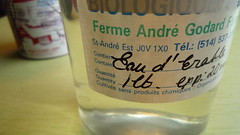Mon pays c'est...
An interactive map based on Gary Paul Nabhan's new book Renewing America's Food Traditions: Saving and Savoring the Continent’s Most Endangered Foods appeared in The New York Times the other day. The map is essentially a fancier, interactive version of this map fig. a: RAFT map of North America
fig. a: RAFT map of North America
and it highlights the plight of the 93 endangered foods discussed in Nabhan's book--93 out of his ever-expanding list of over 1,000 such foods. As you can see, in order to do so it divides North American into about a dozen food "nations"--geographic regions that share particularly strong food-based commonalities. Rolling over each region with your cursor allows you to see a list of some of the region-defining foods that are now endangered there. Thus, the Pacific Northwest gets the name Salmon Nation because of the Snake River Chinook salmon's threatened status, and the region's other endangered foods include everything from the Gillette Fig to the Olympia oyster. On the other hand, the Southwest's Chili Pepper Nation designation refers to the threatened El Guique New Mexican chili pepper (and not necessarily to the region's musical preferences), and its endangered foods range from Chapalote popcorn to the Wild Tomatillo of the Continental Divide. The Northeast consists of Clambake Nation and Maple Syrup Nation.
(If you have no idea what I'm talking about, or can't picture the interactive aspects of what I'm describing, or if you'd just like to take a look for yourself, you can find the fancy interactive map here and the accompanying article here.)
As The New York Times makes clear, the book's somewhat paradoxical advice is that, in most cases, consumption is the key to preservation--reintroducing many of these foods to your plate is not only a way of rediversifying one's diet while also eating more regionally, it can also be a way to ensure that these foods don't disappear entirely.
In the case of the Montreal region that would mean reintegrating three endangered items--"hand-harvested wild rice," the Chantecler chicken, and "American eels of Lake Ontario and the St. Lawrence River"--into your diet. "But, wait," you say. "What about the 'Sugar Maple of the Allegheny Plateau'? I thought we lived in Maple Syrup Nation." Well, I haven't read Nabhan's book yet, so all I can do is go by the the maps (schematic though they may be), the article, and the online information provided by RAFT and Slow Food USA, but by the looks of it Maple Syrup Nation sweeps right around Montreal (forming a crescent to the south, east, and north) and we actually belong to Wild Rice Nation, which encompasses a long swath of land that cuts across Southern Quebec, Michigan, Wisconsin, Minnesota, North Dakota, Manitoba, slivers of New York, Pennsylvania, Ohio, Indiana, Illinois, and Saskatchewan, and a healthy chunk of Ontario.
Now, we're no Ontariophobes, but I'm not sure how attached Michelle and I feel to Wild Rice Nation. We like the idea of the famous Chantecler Chicken (the pride and joy of Oka, QC) being raised in a sustainable manner and we definitely wouldn't mind if the unagi at our neighborhood sushi bar was local, but neither of us have ever really associated this region with wild rice. We were pretty sure we were living in Maple Syrup Nation, or Fiddlehead Nation, or maybe even Ramps Nation. And from time to time we'd been known to decamp and show allegiance to Clambake Nation, Crabcake Nation, Corn Bread & BBQ Nation, Gumbo Nation, and Chili Pepper Nation too. But, seriously, if we're not a part of Maple Syrup Nation, why the hell do we have a bottle of fresh eau d'érable fig. b: the elixir of life
fig. b: the elixir of life
in our refrigerator at the moment? (One that we bought not two blocks away from here, no less.)
Still, it makes you wonder. What are the foods that define us as a region? What are the foods that we can't afford to lose? And how does the RAFT map affect the notion of a distinct society?
aj








2 comments:
Hi there
I have just stumbled upon your blog. I love the clean design and fantastic photos. I am a blogger myself and always thought that design was key and you have certainly captured that! There are so many food blogs out there these days and being different to all the others is key. I have just started www.ifoods.tv which is a website for chefs, foodies and food bloggers to hand out, share recipes, photos and videos. When i was blogging I always thought i should be getting more traffic as my blog was getting lost in the masses of stuff out there so my new site is aimed at giving food bloggers and chefs a bigger platform! Hope you enjoy it and keep up the good writing and design here! I have now bookmarked you so will be regular reader, Cheers!
Hi PC,
Thanks for reading and thanks for the friendly feedback. I'm going to go check out your site right now.
Post a Comment